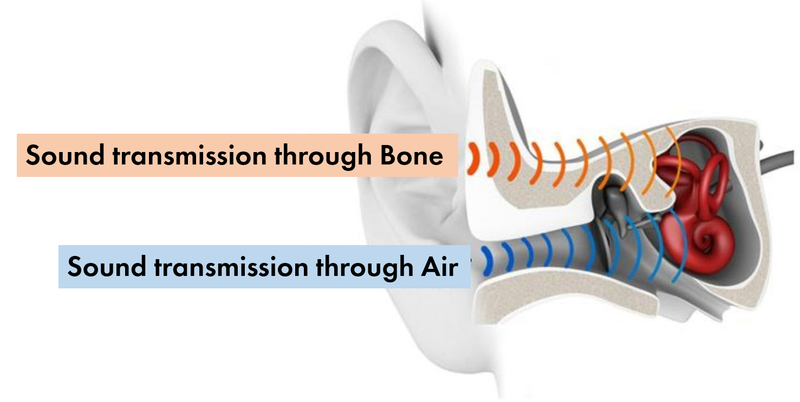There is nothing quite like a bass line you can feel in your bones, a chest-pounding kick drum or a vibrating electronic bass loops. Increasing the impact of low frequencies is not the only good reason to add a subwoofer to your PA system. It is time to look at the benefits of using subwoofers in live sound applications and understand how to best integrate them to your PA system.
Hearing Low Frequencies
First, let’s recall that the commonly stated range of human hearing is 20 to 20,000 Hz and that the human auditory system is most sensitive to frequencies between 2,000 and 5,000 Hz. Also due to the very long wavelengths of low frequencies, our brain is not able to localize them based on either time or sound intensity differences, as it does with the rest of the audible sound spectrum. Note that as we get older, our low frequencies hearing abilities remain identical while they decrease in the high frequency spectrum.
Let’s add here that our bones also transmit low frequency sounds. This phenomenon is called ‘bone conduction’, allowing vibrations to be transmitted to the inner ear primarily via the bones in our skull. Note that it is difficult for the average individual to distinguish sound being conveyed through the bone, as opposed to sound being conveyed through the air via the ear canal.

What do you mean by Low Frequencies?
In order to set some grounded definition of low frequencies, let’s look at how music theory has divided the audio spectrum. A simple and undisputable reference is the musical octave. Our audible frequency spectrum covers ten musical octaves, which can conveniently divide the spectrum as defined in the table below.
| Subsonic low frequencies | Below 16 HZ | Not audible for humans |
| Very low frequencies | 16 Hz – 40 Hz 40 Hz – 80 Hz |
Lowest audible actave Music low frequencies, kick drum, bass instruments |
| Low frequencies | 80 Hz – 160 Hz 160 Hz – 320 Hz |
Low register of a grand piano Middle C of a piano |
| Midrange frequencies | 320 Hz – 1’280 Hz | Music midrange frequencies |
| Upper midrange frequencies | 1’280 Hz – 2’560 Hz 2’560 Hz – 5’120 Hz |
Low-order harmonics of most musical instruments Most sensitive octave for the human ear |
| High frequencies | 5’120 Hz – 10’240 Hz | Brightness and harmonics |
| Extremely high frequencies | 10’240 Hz – 20’480 Hz | Highest harmonics. Inaudible to human ear beyond 20 kHz |
The word ‘bass’ is usually related to frequencies between 20 Hz and 200-250 Hz, but as we refer to musical octaves, our definition can be a little more accurate.
If your main loudspeakers are able to reproduce low frequencies down to at least 80 Hz, typical subwoofers will be able to take over the reproduction of the three octaves below. This explains why QSC active subwoofers, and many other models and brands, offer crossover frequencies set at 80 Hz and/or 100 Hz.
Benefits of using a Subwoofer
A well-designed, high performance subwoofer elevates the listening experience in a way no other audio component can. There are various reasons why subwoofers can enhance your live sound performances.
Revealing hidden audio contents – Most live sound two-way loudspeakers’ response start to roll off around 50 Hz, which deprives you of the full transient, depth and clarity of low frequency tones. A quality subwoofer will reach down to 30 Hz, or lower. This means you will never miss these low octaves and will be able to feel even the lowest notes from something like a large pipe organ, a kick drum, a six-string bass guitar or dramatic sound effects.
Additional headroom for the main loudspeakers – In many PA systems, when nearing the loudspeakers’ maximum SPL, woofers often reach their maximum displacement capabilities and distortion arises. A subwoofer will be able to handle such low octaves with ease, as it always features a larger woofer(s) with higher power handling and displacement capability. When combined with a subwoofer, which will handle part of the lowest spectrum main loudspeakers usually reproduce, the main systems will be able to handle higher sound pressure levels and greater dynamics with low distortion, as their reproduction bandwidth is reduced. To achieve this accurately, one needs to use audio crossovers that are, basically, electronic filter circuitry which split up an audio signal into two or more frequency ranges, so that the signals can be sent to separate loudspeaker units, or loudspeaker drivers. Note that all QSC active loudspeakers and subwoofers feature on-board audio crossovers.
Accurate reproduction of the low frequency spectrum – Unlike a vast number of full-range loudspeakers, which have inherent sonic signatures – or coloration – most well designed subwoofers have less tendency to color the original signal. A faithful reproduction of musical content implies high dynamic reproduction capabilities, rich harmonic content and plenty of headroom. This is one of the reasons why a quality subwoofer can be combined with any loudspeaker model to add weight and energy to the overall listening experience. In doing so, one highly important issue is to make sure both main loudspeakers and subwoofer(s) share a perfectly matched crossover frequency, therefore ensuring a smooth audio transition between them.
More placement options – From a practical point of view, a main loudspeakers and subwoofer(s) combination is a lot easier to site and move than full range, large PA systems. Smaller form-factor loudspeakers are light and easy to deploy. Additionally, people frequently underestimate the effect placement can have on the sound of their loudspeakers. In fact, depending on where you place your loudspeakers in a room or venue, a number of unwanted first reflections as well as bass boost due to nearby wall’s loading may compromise the overall quality of the sound reproduced. If the positioning of main loudspeakers usually have a number of constraints (on the side of the stage, or the screen, at specific places to cover the audience adequately, etc), the placement of a subwoofer(s) gives you a lot more freedom. There are a few simple rules to follow regarding sound cancellation with the wall behind the subwoofer and some necessary clearance for reflex ports to work optimally. However, beside these, getting optimal sound from a subwoofer(s) is easily possible in a much broader range of positions (for more details check this article called ‘How to correctly place a subwoofer in a room’).
How to integrate a subwoofer to your PA system
For several years, a mixing technique called ‘aux mix’ or ‘aux fed subs” has been developed to reduce low frequency ‘muddiness’ from front-of-house PA systems (for more details, check out our video on this topic). This technique has resulted in considerable benefits for a wide variety of sound reinforcement applications, so let’s clarify the details.
The Crossover Method
The standard method to integrate a subwoofer in a PA system is to run the main output of the mixing console through a crossover network, which splits the signal into multiple frequency bands and sends each band to different power amplifiers and passive loudspeakers. In the case of active loudspeaker/subwoofer systems, the output of the mixing console is fed to the subwoofer(s) and the filtered, high pass subwoofer outputs are sent to the main loudspeaker(s).
In both cases, this method has the advantage of simplicity. Once the PA system is configured, the mixing engineer does not need to manage the subwoofer(s). However, if the mix engineer is not diligent about using high pass filters on specific channels, which do not need extended low frequency sound to be reproduced by subwoofers, the main mix can become muddy, loosing clarity and definition.
The Aux Mix Method
The other method involves sending a dedicated Aux (auxiliary) mix to the subwoofer(s), usually derived from a ‘post-fader/post-EQ’ auxiliary send. By routing channels through this Aux mix, any changes in individual channel fader position will result in a comparable change in the subwoofer level – as in the ‘crossover method’.
In most cases, this Aux mix will only include channels, which contain significant low frequency content, such as bass guitar, kick drum, electronic bass sounds, etc. The significant advantage of this method is that it only selects sound sources that need an added low frequency extension via the subwoofer(s), preventing low frequency muddiness from creeping into the main mix.
Conclusion
Looking past the technical enhancements, having a subwoofer in your PA system adds a completely new dimension to music. A great-sounding subwoofer should never be overbearing or boomy, but instead, should add color, depth and impact to the reproduced sound. From infectious bass guitar riffs and hypnotic drumbeats to the most complex electronic bass compositions, a quality subwoofer will be able to reveal additional layers of sounds and elevate the listening experience and the entire performance.
Most subwoofers are designed to handle frequencies below 100 Hz typically, taking the deepest bass frequencies out of the main loudspeakers. While this does not always increase notably the volume of the main loudspeakers, by spreading out the workload between loudspeakers and subwoofers, you can add an amazing level of clarity and fullness to the sound of your PA system.
Christophe Anet
Latest posts by Christophe Anet (see all)
- History, Development and Applications of Column Loudspeakers - May 30, 2025
- Why is Dynamic Range so important? - May 30, 2023
- Differences between Flown and Floor-Mounted Subwoofer Deployments - May 2, 2023

Is there an article that would explain more on depth regarding the Aux mix method for subs?
Hello Kenny, we have a series of four training videos covering these aspects. More learnings here: https://www.youtube.com/watch?v=wKLiOXBIz60.
All the best, Cheers, Christophe Anet